The House will be controlled by the Republicans this November, with seven seats left. This leaves Democrats needing a dramatic turnaround to keep their power. The Fox News Power Rankings’ latest edition featured the U.S. House Model for the first time and Josh Shapiro (a Democrat) gaining a slight edge in Pennsylvania.
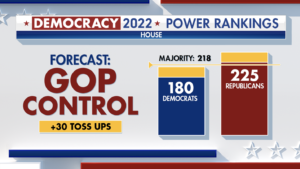
The Power Rankings model shows a clear advantage for Republicans in the House, with redistricting complete and most of the primaries over. The GOP will be able to win 225 seats compared to the 180 held by the Democrats, with 218 needed to take control. These figures do not include races where one party holds a majority. The size of the GOP majority will depend on how many high-competitive “toss-up” races each party wins. However, Republicans are expected to win at least a seven-seat majority (225 seats) and as high as 37 seat majority (255 seats) under their “best case” scenario.
There are many scenarios that the Democrats can choose from, leaving them with a 38-seat deficit (180-seats) or eight seats short of a majority (220 seats). This is significant. This means that even if Democrats win all the 30 currently toss-up races, they still don’t have enough support to keep control of the House.
Readers of the Eagle-eyed Power Rankings would be aware that these ratings are only estimates and that races assigned to parties (especially those in “Lean”) are still highly competitive. However, congressional Democrats are still facing a very uncertain future.
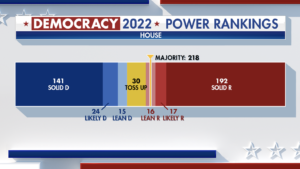
The gloomy outlook is largely due to President Joe Biden’s approval rating. A New York Times/Siena poll on Monday found that Biden’s approval rating is just 33%. Several high-quality polls show that Biden has a lower rating now than former President Donald Trump. Biden’s current rating is similar to Trump’s approval rating, which foreshadowed their solid win in the House.
According to polling, voters are frustrated by the rising cost of living, especially in key categories like food and gas. This frustration can be seen in both how voters feel about it and in the way they prioritize their concerns. Americans are punishing the president, and indirectly, congressional Democrats.
This story is not only based on numbers but also includes a glimpse into battleground state decisions. Senator candidate Tim Ryan (D-Ohio) missed an appearance in Cleveland with Biden earlier this week. Georgia gubernatorial hopeful Stacey Abrams stated that she would welcome anyone to join her on the trail during a recent interview with Fox News Sunday. Democratic strategists are expressing concern about Biden’s ability to fight for their core priorities.
This results in a congressional map that allows Republicans to retain the seats they need and open up new territories. There are 13 seats that Democrats hold in the “Lean R”, and “Likely R” categories. However, only one Republican holds a seat in either the “Lean D” column or the “Likely D”. TX-34 is where Mayra Flores, newly sworn-in Representative, will face a more blue-redistricted electorate during November. This gives the GOP the opportunity to play offense all across the country. Numerous pickup opportunities exist in swing states like Colorado and Nevada that have been trending blue during the Trump era. Five Democrat-held districts in Connecticut, a state which voted for President Biden 20 points higher than Connecticut, are still competitive.
This is the asterisk. Voters still feel the effects of the Supreme Court’s decision to invalidate the constitutional right to abortion. According to a Fox News poll, 63% of voters supported Roe v Wade being left alone. Only 11% believe abortion should be “always” illegal, despite the fact that some Republicans from competitive districts support a no-exceptions policy.
This reversal likely contributed to a 1-2 points increase in support for Democrats, in generic ballot polling. The Democrat on the Nebraska special election ballot last week exceeded expectations after campaigning against it. Inflation was the top concern of voters by 31 points in a Fox News Poll two weeks prior to the ruling. Evidence has yet to support a shift in priorities. It is still too early to know if the Supreme Court’s Dobbs decision will increase support for congressional Democrats in November.
If you look at the individual races, you will see that many of the most competitive areas share key characteristics.
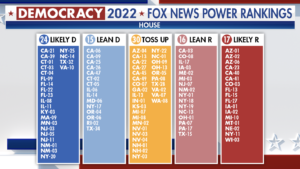
First, the House is going to be won in suburbs. This set of rankings puts at risk several Democrats who were elected on the back of suburban women supporting Trump. Sharice Davids (KS03), one of the two first Native American women elected as Congressmen, is trying to keep her position as the only Democrat in Kansas’ heavily suburban district (ranked Toss-Up). She is also up against tough competition from her colleagues, Rep. Susie Lee in Nevada-03 and Elaine Luria in Virginia-02 (both Toss Ups). Abigail Spanberger (VA07), who may be the reason she said last year to the New York Times that “nobody elected Biden [to be FDR]”. For Rep. Susan Wild (PA07), whose district includes suburbanized areas in Allentown and Bethlehem and whose race is ranked LeanR, the prospects are slightly less. She faces female Republican challengers who focus heavily on education and the cost of living.
Democrats could also lose key districts that have high Hispanic populations. TX-28 will be the closest battle. Rep. Henry Cuellar, the incumbent, will attempt to convince his party that his brand is more appealing than a progressive platform to Hispanic voters. This race is ranked Toss-Up. The East Coast incumbent GOP Rep. Maria Salazar will face a slightly liberal electorate following redistricting. However, FL-27 is home to a large Cuban community. Recent surveys show that these voters are gravitating towards the GOP. Republicans could retain Flores’ District in TX-34. This district is currently ranked Lean C. It will also show that Hispanics are leaving the left.
This cycle will see Trump’s influence on Republican Party members also tested. Trump has endorsed Madison Gesiotto Gilbert, a social media influencer and former campaign surrogate. In a fight against Emilia Sykes, she will try to turn the newly redistricted 13th by highlighting her connections to the 45th President. This race is a toss-up. Pay attention to NC-13, which features Bo Hines, a former college football player. This race is ranked Lean-R and will determine if Hines’ endorsement by Trump and the far-right Freedom Caucus will appeal to voters in exurban districts.
A few of the 333 districts shown in the “Solid” columns provide insight into the political spectrum. The Power Rankings predict a decrease in the size of the Democratic caucus. However, the power of the far-left “Squad” is expected to increase. Summer Lee (PA-12), and Greg Cesar, (TX-35), are both candidates in “Solid D” areas. Both favor Medicare for All (and the Green New Deal).
It is all about consolidation. Both Controversial Representatives Matt Gaetz (CO-03) and Marjorie Taylor Greene will likely retain their Solid R districts. Lauren Boebert, the CO-03 incumbent representative, is more vulnerable due to a “likely” ranking. However, it would surprise to see a district that has been held for over 11 consecutive years by a Republican turn back to the Democrats in this national climate.
The House model is ready to respond to any changes in the environment over the coming months. The overall math for Republicans is good as it stands in July. The Power Rankings project a majority of between 7 and 37 seats, it is most likely that the GOP will govern the lower House in November.
Senate: Republicans lead but the Toss-Up races are still required to take a majority.
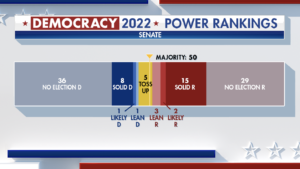
The Senate Power Rankings remain unchanged from the previous edition. They paint a slightly rosier picture of the Democrats. While the GOP has more races than the Democrats in its party columns, neither has enough to form a majority without including Toss-Up races.
It is clear that the Republicans hold the advantage in this area. The GOP holds 49 seats in the Solid R, Likely R & Lean R columns, plus 29 seats not up to the election in 2022. To take control of the Senate, the GOP must win two of five Toss-Up races. Democrats will need to win four to achieve a 50-seat majority with the help of Vice President Kamala. But, these Toss-Up states are too competitive to give one party an advantage. This category includes Arizona and Georgia as well as New Hampshire, Nevada, Nevada, and Pennsylvania.
Governor: Pennsylvania moves to Toss-up – Lean D
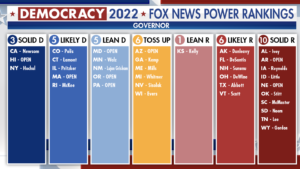
Pennsylvania moves from the Toss-Up category to Lean D on the gubernatorial front, giving Democrat Josh Shapiro a slight advantage in his bid to retain the state for 2022.
Since the last Power Rankings, two things have changed in the Keystone State. Primarily, voters chose Josh Shapiro, Democrat Attorney General, and Doug Mastriano (Republican state Senator) as their major party candidates. Mastriano is running for a range of extreme Republican policies. These include making Pennsylvania a “Second Amendment Sanctuary” as well as supporting fringe conspiracy theories. Mastriano was also interrogated by the FBI following his appearance outside the U.S. Capitol on Jan. 6, 2021. It will be difficult for the sitting senator to convince voters in a state where he was voted for by President Biden that he is the best person to lead them into 2024.
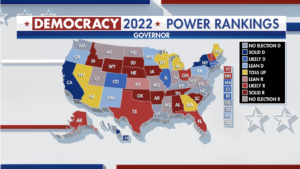
Second, it is too early to predict the impact of Roe v. Wade being overturned in the House forecast. The decision has the most impact on the gubernatorial race, where state leaders will be responsible for setting the abortion access legislation. Mastriano would ban all abortions, with no exceptions, to save the mother’s life. This is a controversial position in the Keystone State where 58% of likely voters believe abortion rights should not be protected. Shapiro, however, has made access to abortion a central plank of his platform.
Keep in mind, however, that Shapiro only had a 4-point lead against Mastriano in the same Suffolk poll (44% for Shapiro and 44% for Mastriano within the +-4.4-point margin of error), so this is still a highly competitive race. Pennsylvania is now Lean D.
The road ahead
There are still a few crucial showdowns in the primary calendar for the 19 states that have yet to elect their major party candidates. Look out for key elections in Arizona for Senate and Governor candidates on Aug. 2 as well as a series of interesting House primaries in Washington. The fates of Sarah Palin, Rep. Liz Cheney, and others will be decided by primary voters in Alaska or Wyoming two weeks later. On Aug. 23, voters in Florida and New York will vote for their congressional districts. Big names such as Reps Jerry Nadler, Carolyn Maloney, and former far-left mayor Bill de Blasio are on the ballot.
The general election is now just a few days away. There are still 120 days until Nov. 8, the general election. This means that there will be a flood of data and news from all over the country.




